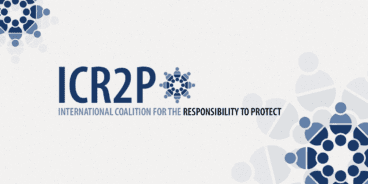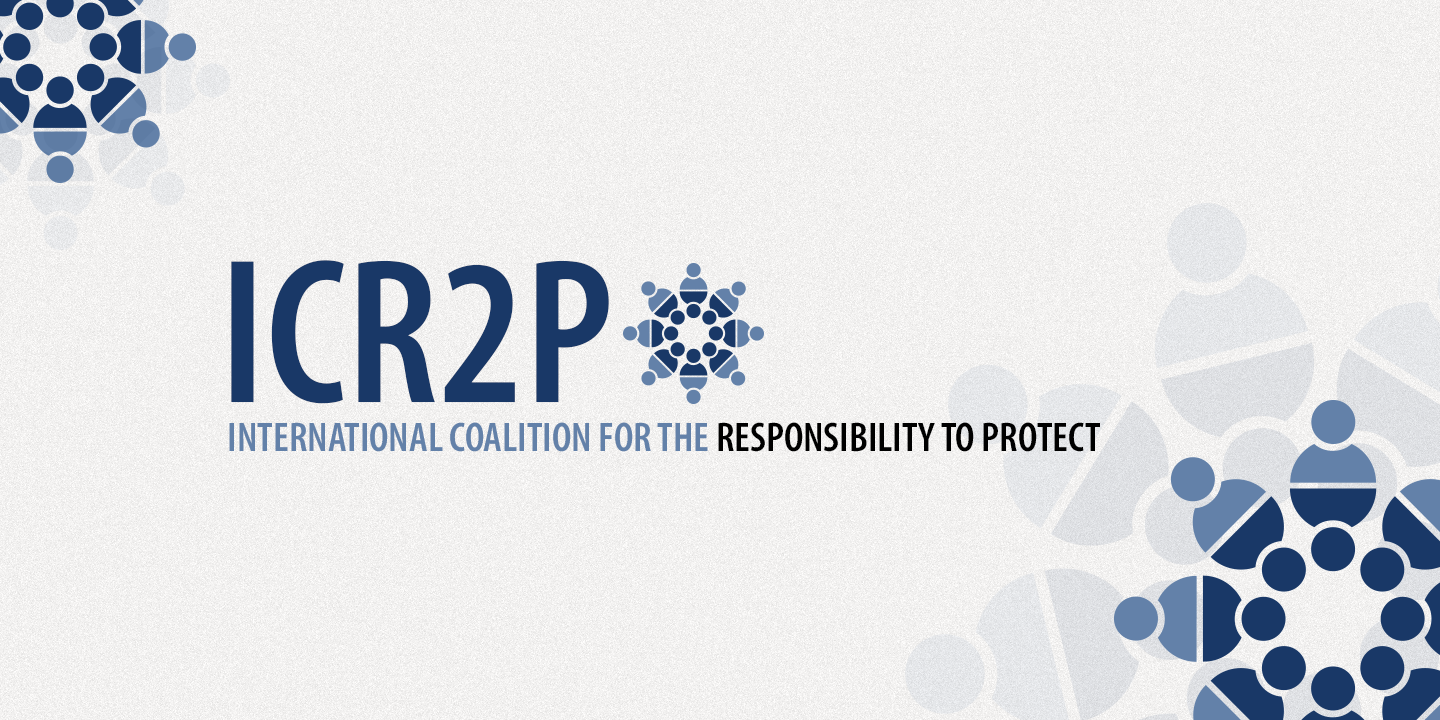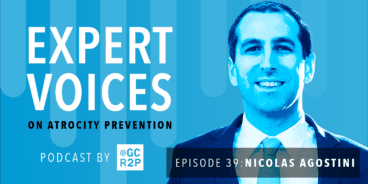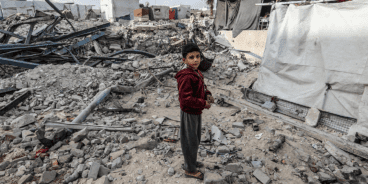

Call to Action for the United Nations General Assembly during its 79th session from the International Coalition for the Responsibility to Protect
As UN member states proceed through the 79th session of the UN General Assembly, they will have an opportunity to renew and deepen their collective commitment to upholding the key pillars of the UN – human rights, peace and security, the rule of law and development. This session is also a pivotal moment to set an ambitious agenda for protecting populations through effective multilateralism, particularly as the world faces a convergence of crises ranging from conflict to climate change.
At the 2005 World Summit, states committed to a collective responsibility to protect populations from mass atrocities, namely genocide, war crimes, crimes against humanity and ethnic cleansing. The 2005 World Summit Outcome Document not only established the Responsibility to Protect (R2P) principle but also set a transformative roadmap for international human rights governance, including the creation of the UN Human Rights Council (HRC) and the Universal Periodic Review. This was a key moment in bolstering global commitments to atrocity prevention.
Nearly two decades later, the state of multilateralism has shifted. The 2024 Summit of the Future, and its resulting Pact for the Future, regrettably omits direct references to R2P and falls short in offering a clear roadmap for effective atrocity prevention and implementation of its various commitments. In this regard, the International Coalition for the Responsibility to Protect (ICR2P) calls on all UN member states to fulfill the following commitments during the 79th session.
1. INTEGRATE ATROCITY PREVENTION PRIORITIES IN THE IMPLEMENTATION OF THE PACT FOR THE FUTURE
The recently adopted Pact for the Future presents a vision and a unique opportunity for the UN to enhance its toolbox to prevent outbreaks or escalations of hostilities and to ensure that approaches to prevention, response and resolution do not remain siloed. The Pact calls for the revitalization of the UN General Assembly’s role in maintaining international peace and security, emphasizing the need for greater use of its authority to address evolving global challenges. It also sets the stage for reforming the UN Security Council (UNSC) by outlining parameters aimed at enhancing its effectiveness, accountability and capacity to respond to emerging global threats, including atrocity crimes.
It is crucial for R2P and atrocity prevention to be at the heart of our shared mission to advance peace and security, human rights and development. ICR2P urges UN member states to incorporate atrocity prevention as a central component in the development of a concrete implementation plan for the Pact for the Future. Atrocity prevention and the effective implementation of R2P can contribute to fulfilling the core values of promoting peace, investing in prevention and embracing a comprehensive vision of human rights, and to creating a better, more sustainable, peaceful future for our people and planet. Specifically, ICR2P calls on UN member states to affirm their strong commitment to R2P, and to define a comprehensive and timely roadmap for implementation, particularly in addressing the prevention of mass atrocities and providing early warning when risks emerge.
ICR2P also urges UN member states to expand their thinking beyond existing conflict prevention frameworks and assessments that may overlook the range of distinct risks and warning signs associated with atrocity crimes. Societal structures and patterns of behavior that may precede violations and abuses of human rights, identity-based violence and targeting, or mass atrocities may be missed in assessments that are strictly focused on conflict prevention or human rights promotion. By helping to contextualize the drivers of human rights violations, an atrocity prevention lens enables a broader understanding of how root causes and other exacerbating factors give rise to abuses against populations. ICR2P calls on UN member states to strengthen their individual and collective early warning and preventive capacities by integrating an atrocity prevention lens into all peace, security and human rights work at the General Assembly and ensuring human rights violations and abuses are effectively addressed in specific country situations. UN member states should also ensure that analytical frameworks reflect the diversity of populations around the world and the intersectional nature of the unique risks they face.
Practically, UN member states can fulfill this by:
-
-
- Swiftly developing and implementing a clear roadmap with a defined timeline to implement the pledges made in the Pact for the Future;
- Acknowledging the important interlinkages between R2P and atrocity prevention and the promotion and protection of human rights, achieving the Sustainable Development Goals, strengthening the Protection of Civilians and addressing peace and security implications of climate change, food insecurity and global health issues;
- Ensuring information collected and presented before the HRC, UNSC and General Assembly, as well as its various committees, includes an assessment of specific atrocity risks and how to best address them;
- Leveraging meetings under Resolution 76/262, which mandates a meeting of the General Assembly whenever a veto is cast in the UNSC, to ensure member states are effectively responding to atrocity situations and upholding their responsibility to protect;
- Regularly raising risks of atrocity crimes in country situations when participating in segments with relevant bodies, including the Third Committee, the Economic and Social Council, the Peacebuilding Commission and elsewhere;
- Highlighting risk factors and indicators in the UN Framework of Analysis for Atrocity Crimes when discussing country situations;
- Replicating multilateral commitments to upholding R2P at the national level by integrating atrocity prevention concerns in national strategies, mechanisms or policies as recommended by the UN Secretary-General in his 2017 annual report “Implementing the Responsibility to Protect;”
- Becoming a member of the Group of Friends of R2P and the Global Network of R2P Focal Points.
-
2. MOVE FORWARD WITH NEGOTIATIONS FOR A CRIMES AGAINST HUMANITY TREATY
Crimes against humanity, along with genocide and war crimes, are considered to be the most serious crimes in international law. Crimes against humanity have been committed all over the world, with millions of people being subjected to atrocities that have shocked the conscience of humanity. Unlike for genocide and war crimes, there are currently no stand-alone international treaty obligations to prevent and punish crimes against humanity. This legal gap perpetuates impunity and creates a false hierarchy between atrocities, despite the equally egregious nature of genocide, war crimes and crimes against humanity. ICR2P strongly believes that in order for the Pact for the Future to be effective, persistent impunity and the growing disregard for the rule of law must be addressed.
In 2019 the UN’s International Law Commission (ILC) adopted the Draft Articles on Prevention and Punishment of Crimes Against Humanity to the UN General Assembly’s Sixth Committee, recommending that these articles serve as the basis for an international treaty. Following a resumed session in April 2023, a debate during the October 2023 session, and another resumed session in April 2024 on the substance of the Draft Articles, the Sixth Committee will again discuss the topic for a final time in October 2024 and take a decision on whether to move forward with formal treaty negotiations.
The potential formal treaty negotiations present an opportunity to close the critical legal gap in the architecture of atrocity prevention and punishment. A stand-alone treaty on crimes against humanity will significantly contribute to three closely interlinked objectives: the prevention of these crimes, enhanced cooperation between states as a result of harmonization across legal systems and the provision of the necessary framework for prosecution and punishment. Moreover, such a treaty would open new pathways to accountability and would help ensure that the rights of victims and survivors remain at the forefront of international legal efforts.
As such, ICR2P urges UN member states to support moving forward with formal negotiations for a crimes against humanity treaty and to meaningfully participate in the subsequent discussions. ICR2P also calls on UN member states to approach the development of a new crimes against humanity treaty with a gender-competent, survivor-centric and intersectional lens. This includes ensuring the inclusion of a non-discrimination provision that is consistent with international human rights law, as well as robust provisions on victim and survivor participation and protection, and avoiding any language that limits legal protections.
3. FACILITATE AND ENSURE MEANINGFUL AND INCLUSIVE PARTICIPATION OF CIVIL SOCIETY AND AFFECTED POPULATIONS, INCLUDING SURVIVOR COMMUNITIES
The participation of civil society and affected populations, including survivor communities, is critical to the prevention of and response to atrocity situations. Such groups are equipped with an in-depth understanding and expertise that UN member states should incorporate and centralize throughout all stages of atrocity prevention.
Civil society actors and affected communities hold a deep understanding of the complex factors that drive violence in their specific contexts, as well as the protective strategies that can mitigate harm. These actors are often the first to witness and document the indicators and early warning signs of atrocities – they are also often the people defusing tensions among their communities, even amidst escalating violence. When violence does escalate, communities themselves are often the first to lead and implement unarmed protection strategies that save lives. Communities, survivors and civil society also play a critical role in the aftermath of atrocity crimes, often driving advocacy for justice, accountability and redress and peacebuilding and reconciliation initiatives. The economic and social devastation inflicted by atrocity crimes most severely impacts civil society and affected populations. Civil society actors and affected communities are therefore best placed to understand the strategies required for long-term sustainable growth, including the most appropriate development measures that can facilitate structural prevention.
Ensuring the meaningful participation of civil society and affected populations requires the robust inclusion of various identities, enabling a greater recognition of diversity within a particular group or community. Affected populations are not monolithic, and their protection needs can vary significantly. By failing to include a wide range of voices – such as women, Indigenous Peoples, LGBTQIA+ individuals, people with disabilities and ethnic minorities, among others – atrocity prevention efforts may perpetuate marginalization and ignore critical warning signs or risks specific to these groups. A comprehensive atrocity prevention strategy must therefore prioritize not just the inclusion but the centering of diverse voices from civil society and affected communities.
ICR2P calls on all UN member states to individually and collectively center and embed the lived experience, knowledge and rights of civil society and affected populations throughout all stages of the decision-making processes, particularly in crafting development priorities, as well as technical assistance and capacity building efforts. UN member states can do so by holding regular consultations and briefings with civil society and affected communities, as well as systematically seeking their insight and input with a conscious effort to avoid re-traumatization and tokenization.
Member states should also ensure that civil society access to UN spaces, including the General Assembly, is safeguarded and feasible, including by alleviating administrative burdens on organizations with limited resources and regularly funding any interpretation or translation services to overcome language barriers. In doing so, the international community can take more appropriate, inclusive and effective preventive action that is rights-based and community-informed. By embracing intersectionality and fostering meaningful participation, UN member states can take more comprehensive and effective action to prevent atrocities and build sustainable peace.
4. REINFORCE AND STRIVE FOR A COHESIVE AND EFFECTIVE MULTILATERAL SYSTEM
A cohesive and effective multilateral system is crucial to helping the international community uphold their collective Responsibility to Protect. Efforts like the Pact for the Future and the draft Crimes Against Humanity treaty offer significant potential to reinforce this cohesion, provided they are applied consistently and without double standards. The selective application of international law and accountability mechanisms undermines the credibility of the UN and the multilateral system, weakening its ability to prevent atrocities. Avoiding double standards in atrocity prevention requires a commitment from UN member states to treat all situations of mass atrocities and human rights violations with equal urgency, regardless of geopolitical interests.
It is also critical to upholding the UN Charter and ensuring that multilateralism delivers peace, dignity and equality for all people as articulated in the Pact for the Future. ICR2P calls on UN member states to hold one another and the international community accountable for their obligations under international law, including the UN Charter.
The current siloed approach by the UN system to issues of human rights, peace and security and atrocity prevention often inhibits crucial information and early warning to be shared with all relevant UN departments and bodies, including the UNSC and General Assembly. Effective prevention of atrocities can only be achieved if the UN system responds holistically by using all the tools and mechanisms at its disposal and ensuring that all relevant information and capacities are shared and acted upon. This includes utilizing tools for the protection of human rights to inform discussions of international peace and security and better operationalizing tools for the maintenance of peace and security in the protection of human rights. Similarly, greater cross-departmental collaboration, including partnerships between the UN Office on Genocide Prevention and the Responsibility to Protect and other UN bodies, will contribute to enhancing the UN’s collective capacity to prevent atrocity crimes or halt their occurrence.
ICR2P hopes that this call will translate into genuine concerted efforts to protect populations from mass atrocity crimes, hold perpetrators accountable and prevent atrocity risks from escalating. ICR2P and its member organizations stand ready as resources of support, early warning and expertise for member states in fulfilling this responsibility.
Related Content


Expert Voices on Atrocity Prevention Episode 39: Nicolas Agostini
